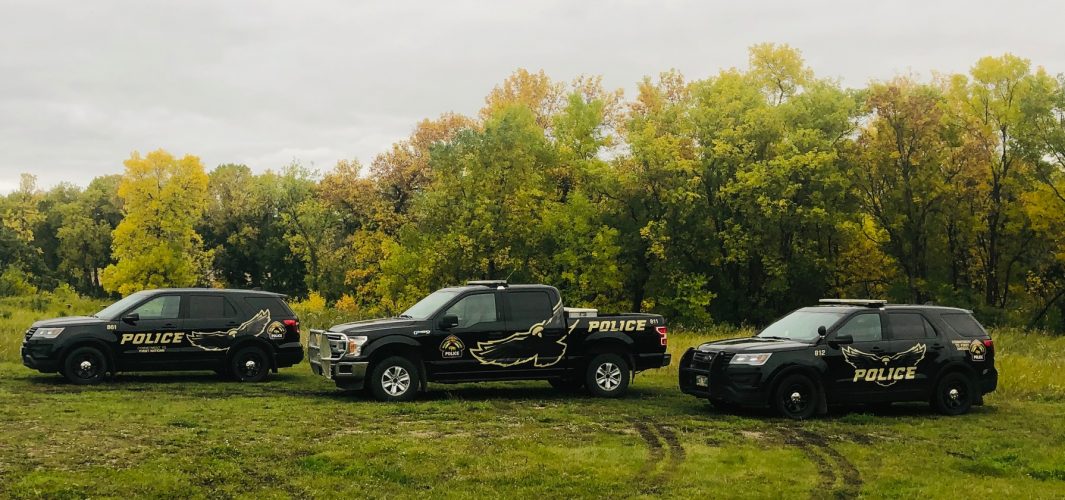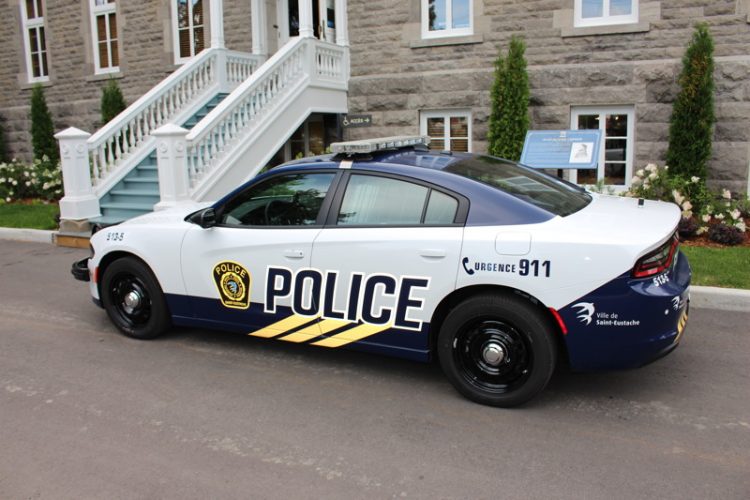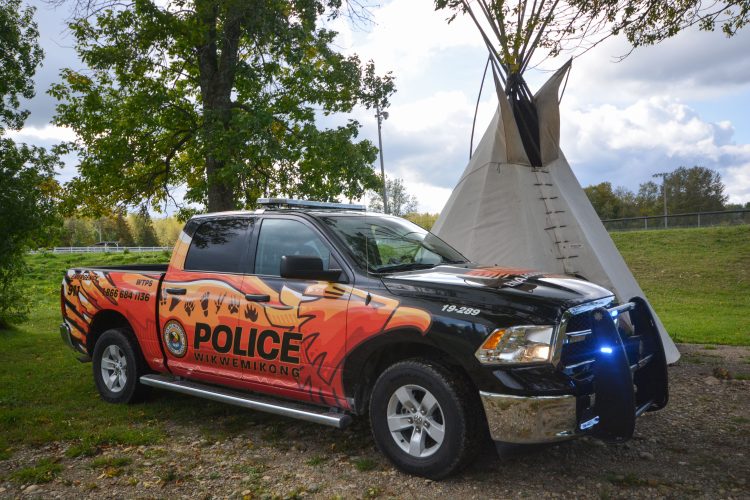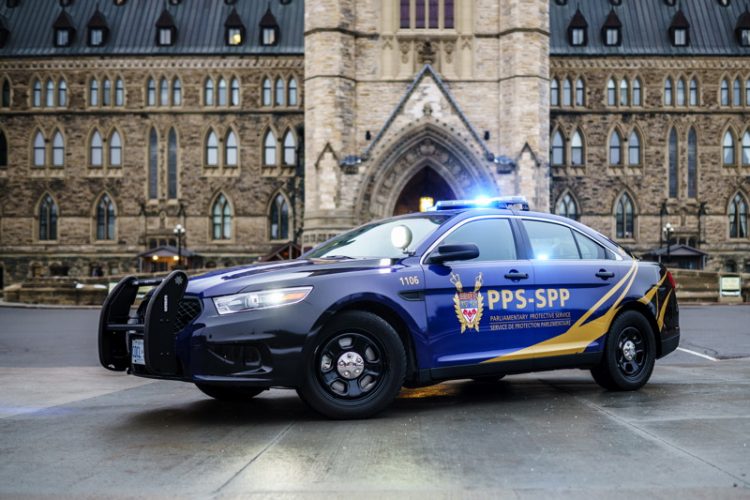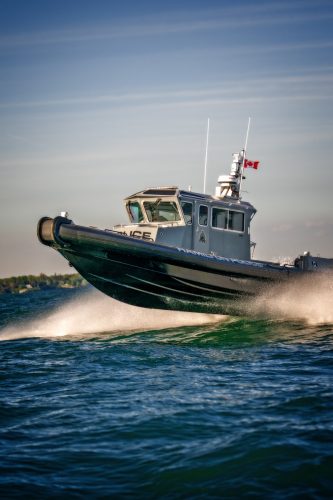
Features
Golden outline design takes the gold
Service de police de Terrebonne comes in on top for Blue Line’s 2020 Best Dressed Police Vehicle Awards
February 4, 2020 By Staff
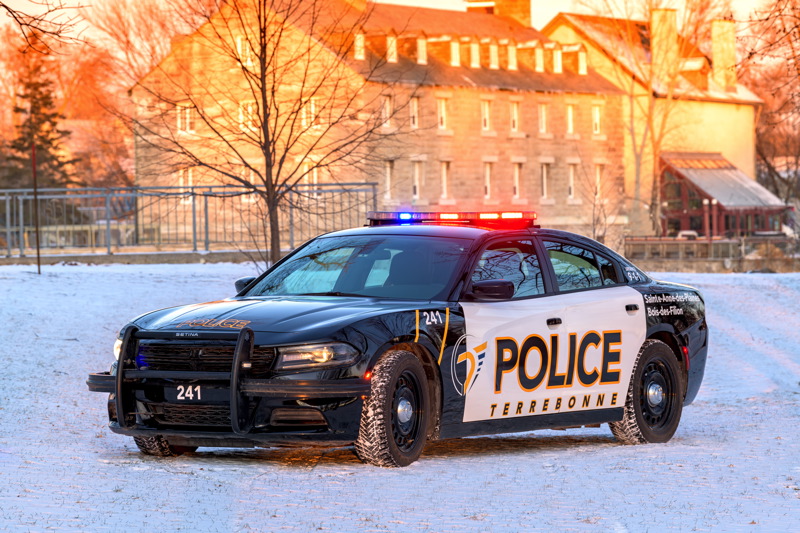 Our judge was impressed by the cars at Quebec’s Service de police de Terrebonne.
Photo: Sébastien Arbour, Arbour Photographe
Our judge was impressed by the cars at Quebec’s Service de police de Terrebonne.
Photo: Sébastien Arbour, Arbour Photographe Congratulations to all the winners of Blue Line’s Best Dressed Police Vehicle Awards. We strive to showcase innovative and effective designs. We look for clear identification, graphic designs that enhance visibility, elements that show directionality of travel and impressive integration of equipment and controls. Of course, we also take “green” vehicles into consideration!
“I am big on officer safety, and this is why I want to see something instantly recognizable as a police car,” says Dave Brown, our long-time Best Dressed judge. “We work so hard on firearms but more often officers are injured or killed in traffic accidents.”
Thank you to everyone who submitted. Stay tuned to blueline.ca for 2021’s call for submissions later this fall.
First Place
Service de police de Terrebonne
2019 Dodge Charger
Quebec’s Service de police de Terrebonne didn’t want just any new fleet design — it had to be one that was “more visible and dynamic,” while also nodding respectfully to the service’s long history. The result is a classic, unmistakable look featuring regal tones of deep yellow, black and white, and capped off at the back with the proud phrase “à votre service depuis 1882,” or, “at your service since 1882.”
The best thing about this new design, according to Terrebonne Police Directeur Marc Brisson, is it was created with suggestions directly from officers. It was a team effort, led by the police department administrators, in which all members of the service submitted ideas for the work wheels. These submissions were then put together by Jessy Brisson, the chief of staff of the dispatch service, to create several different designs. Members could vote on the final design.
“We also wanted to be one of the first municipal police departments in Québec to introduce a black and white car, which has been a universally known design for police cars for many years,” the service notes in its award submission. “When choosing the colours, we redesigned the logo of the police department to reflect colours that align with those used in the traffic act, such as the yellow, which represents caution.”
Dave Brown, not only our judge for these awards but also Blue Line’s firearms and vehicle contributor, says he loves how the word “police” truly jumps out at you on Terrebonne’s vehicles.
“Some agencies try too hard to make the word ‘police’ look different and it can lose that immediacy of recognition that’s so important to a marked patrol car,” he says. “Terrebonne has chosen a simple font (in highly reflective letters) that make it immediately identifiable as a police car. ‘Police’ stands out, both with the easily-readable font and the yellow outline around the letters that is duplicated in the crest and the slash on the front fender.”
The above photo features the 5.7-litre, 2019 Charger, with all wheel drive, but the service also applied their new design concept to the entire fleet, including the trucks.
“We decided to use three colors for our vehicles: all white, all black, and black with white doors,” the service notes in its submission. “We know the population gets used to seeing our patrol cars and after a while, they do not notice us. But with those three colours, and the punchy graphics, we believe they will notice our presence much longer.”
All of the material used for the wrapping of the car is made from pure colour vinyl (3M Wrap Film Series 1080), according to the service; it is not printed ink, meaning the colour will not change or fade. All the “police” letters on the car are cut in 3M “sunflower’ reflective vinyl, the police service adds, in order to make the words as visible as possible.
“The back bumper sports a reflective hazard marker that serves to warn others to give extra space when they go around stopped police vehicles, which helps to keep our officers safe. The colours and shape respect the signalisation of Québec’s traffic act. Overall, the material used is more visible, of higher quality and richer in colour.”
What struck Brown the most was “the timelessness of the design and the simplicity of it.” He says it “works equally well on white, black and black-with-white-doors vehicles… I especially love the way the crest and the word ‘police’ is integrated into the natural lines of the vehicle. The slash on the front fender may seem like a small element but it adds directionality to the design, which is one of the most important characteristics we look for today. Citizens should be able to tell at a glance, day or night, the direction a marked police vehicle is travelling.”
The design does indeed “increase security for all of our drivers and our officers,” Brisson continues. “We love the inscription on the trunk reminding everyone that we have been serving the community with pride for 138 years… We are really proud to be named Blue Line’s best dressed car of the year.”
Second Place
Manitoba First Nations Police Service
2019 Ford F-150 Police Responder
The Dakota Ojibway Police Service officially transitioned to “Manitoba First Nations Police” (MFNPS) in 2018 and to celebrate this, it sought a vehicle design that would reflect all six of the communities it serves in southern Manitoba. MFNPS, a recognized self-administered agency, serves the Birdtail Sioux, Canupawakpa Dakota, Long Plain First Nation, Roseau River, Sandy Bay and Waywayseecappo First Nation communities. Police Chief Rick Head explains the eagle was selected as it is widely accepted as “the protector” in many First Nations’ cultures.
“The Manitoba First Nations Police vehicle design is very clean and simple,” Brown says. “And this is why I love it.”
This truck was the top vote of our intern, Zeba Khan, who describes it as “visually appealing” with a consistent colour scheme and highly reflective, unobtrusive — but still commanding — eagle depiction. She notes how viewers do not end up startled upon seeing it for the first time, nor lost in the details.
MFNPS Insp. Dave Scott says the design marks a fresh start. Out of the 22-vehicle fleet, he notes there are only about two left to fully covert to the redesign.
“Insp. Bruno Rossi played a big role in the design process,” Scott says. “Every time I see an eagle, it’s a very spiritual thing. It’s the master of the skies and it can send a prayer and a message to the creator. It is a symbol of greatness and we are a growing, proud service.”
Avenue 4 Communications staff assisted in the design as well as Accent Striping and Lettering Co. in Brandon, Man. Community members and Elders were also sought out for advice, Head says.
“This design is for all of us and for the future generations.”
Third Place
Service de police de la ville de Saint-Eustache
2019 Dodge Charger Pursuit
The Service de police de la Ville de Saint-Eustache was on a mission to harmonize its new logo with the town colours on its cruisers in early 2019. They succeeded, in the view of our judge, with the clean blue and white design, and highly visible diagonal lines along the bottom of the doors.
“Saint-Eustache is fresh and new,” Brown says. “Plus, as we know, one of the main elements I look for is directionality of a design; can another driver see at a glance which direction a police vehicle is facing night or day. This is what really won me over.”
A duotone design was selected to increase police vehicle visibility, the service notes. “Road users and first responders can recognize the style quickly and easily. This contemporary design boosts visibility and the checkered pattern on the front and rear is modelled on traditional emergency vehicle logo designs.”
The use of reflective vinyl police badges is a key element of the design. The badge displays the police department’s guiding principles of service, rights, prevention and protection, while the other logo on both sides of the vehicle represents the municipality’s soaring swallows, symbolizing the town’s dynamism. The big and little swallows represent the family and family values.
The prominent word “police” — reflective vinyl is used for the contours — and the pictogram of a telephone (accompanied by the terms “urgence” and 911) are “reminders that the police department is a first-line service in tune with our community.”
In addition to the reflective gold badge, “ergonomic oblique lines” of the same vinyl give movement to the overall image and “suggest a quick response and action.”
Designs for all municipal vehicles were also revamped to draw on the new Saint-Eustache police department design.
“This approach generated a sense of security among residents while projecting a harmonious, consistent image,” the service explains. “With their sleek lines and minimal colour, the designs for both police and municipal vehicles are modern and project a sober and dynamic image. Feedback from every quarter has been abundant and positive since the first vehicle appeared.”
Sgt. Philippe Geoffrion represented the police in creating the design as a member of a working committee co-ordinated by Saint-Eustache’s communication department. The committee hired Jules Communications to propose visuals matching certain guidelines. Proposals that were reworked and chosen by the working committee were then submitted to the public safety committee, as well as the communications and citizen relations committee, which is composed of town residents and elected officials.
Community Relations
Wikwemikong Tribal Police Service
2019 Dodge Ram 1500 Rebel
There is no missing this spirited, wrapped truck from The Wikwemikong Tribal Police Service (WTPS). It is an electrifying entry, bursting with a textured orange, yellow, white and brown thunder bird, or eagle. It is also distinct from the service’s regular patrol design, which depicts a grey and white thunder bird with gold highlights.
WTPS serves those on the Wiikwemkoong Unceded Territory on Manitoulin Island in Ontario and prioritized the incorporation of Anishinaabe culture into its vehicles. The WTPS patch, as found on the back door, is centred on the Seven Grandfather Teachings in the form of seven feathers hanging from the medicine wheel. The thunder bird represents one of the Teachings: love. You can also see elements of the other Teachings on the truck by their playful pawprints:
• Bear – bravery
• Beaver – wisdom
• Wolf – humility
• Turtle – truth
• Sabe – honesty
• Buffalo – respect
“I truly hope this vehicle will bring our youth closer to our officers through conversations on the Teachings that are interwoven into the design,” Police Chief Terry McCaffrey says.
Additionally, we were struck by the design on the hood of the vehicle, accompanied by the word “Enaagdawenjiged,” which translates to “the ones who take care of things,” or “the protectors.” This translation was provided by Wiikwemkoong Elder and language keeper Phyllis Williams through a ceremony.
The fonts, too, represent an evolution of First Nations policing that bridge the wisdom of the past into the future, WTPS says.
“The design overall represents a visual response to ‘reconciliation’ from colonial modern-day police to a community-oriented policing, using symbols that define Anishinaabe culture and traditions. The unorthodox designs maintain a balance between legislative requirements and the values of the Anishinaabe in Wiikwemkoong.”
The service goes on to note this design “represents where we come from, our guiding principles, cultural teachings, modern day protection, living in harmony and the respect for all.”
WTPS partnered with Fuel Media in Sudbury, Ont., for help with the graphic and Tehkummah-based Beacon Images also assisted with adjustments and applied the wrap to the truck.
Law Enforcement
Parliamentary Protective Service
2018 Ford Interceptor Sedan
The Parliamentary Protective Service (PPS) amalgamated the Senate Protective Service and House of Commons Security Services in 2015 into a single unified security body to serve the Parliament of Canada. It is a separate and distinct organization from the RCMP and the Government of Canada. This winning car is also the very first official patrol vehicle for the service.
“The vehicle design would establish and accentuate our presence on the Hill,” PPS notes in its submission. “We wanted it to represent elegance, modernity and authority while possessing elements that would easily be associated with our protective mandate. The vehicle had to represent the colours, style and purpose of the organization, and it had to be easy for the public and law enforcement partners to identify it… It was also important for our design to differentiate itself from all other cruisers in the National Capital Region.”
A fully functioning patrol vehicle, complete with lights and sirens, the all-wheel-drive sedan is wrapped in a striking “deep impact blue” colour with sweeping gold and light blue lines. A series of fine white lines was also selected for the back side of the vehicle, immediately underneath the taillights. These add “diversity and depth,” bringing in contrast, while filling in the rear section of the vehicle. Additionally, the impression of artistic shading is created with part of the design printed on a highly reflective safety vinyl decal.
After several colour schemes were considered — including ruby red metallic— the combination of blue and gold was ultimately chosen because it represents the “true branding style” of the organization.
“The uniforms of our protection and detection personnel are also dark blue, with gold contoured shoulder badges and cap crests,” the service explains. “The name of the organization is featured both in the form of a bilingual acronym (PPS-SPP) on the rear and sides, and also it is written out in full in English and French on each side of the vehicle, matching the uniform branding.”
Several gold maple leaves can also be seen on the vehicle, as they are an “essential” part of the PPS emblem, as well as being one of the “most iconic symbols” of Canada.
Special Service
Hamilton Police Service
Marine 1 Patrol Boat
There was an extra number of stunning submissions in this category this year, all of which checked so many of our boxes, but Brown says he simply couldn’t resist the slick new addition to the Hamilton Police Service Marine Unit’s fleet, which went into the waters last June.
“Who would not want to be in that Hamilton Police boat at speed?” he exclaims.
The 12-metre Interceptor aluminum vessel, known as “Marine 1,” was built in Kingston, Ont., by MetalCraft Marine. It is a multi-mission capable platform utilized for marine patrol and enforcement, as well as search and rescue operations on the Hamilton Harbour and the western end of Lake Ontario, an area of over 300 square kilometres.
A committee of marine officers, fleet and command staff was formed for this procurement. Operational needs and end-user input were given high priority, Hamilton Police Service (HPS) notes in its submission.
The hull is designed for stability and performance, with a top speed of 50 knots (92 km/hr) as outfitted with triple 300 horsepower Evinrude outboard engines. “This has significantly reduced response time over the previous (now decommissioned) vessel,” HPS says. “The fully-enclosed cabin is insulated and climate controlled, protecting operators from the elements during the nine months of the year this boat is operational.” The cabin includes ample storage space and shock-mitigating seats for a four-member crew, according to the service. There is also plenty of deck space, it adds, as well as removable dive doors to support person-in-water recoveries and diving operations.
The grey cabin, black collar, and subdued decals also caught our attention.
“At close proximity, the police decals are clear and the vessel is both highly visible and unmistakable as a police boat,” HPS says. “However, from a distance the greyscale can blend more with the water than the previous white police boat, providing an advantage for enforcement and interdiction. This colour scheme matches another vessel Hamilton Police has, and affords some consistency with some of the newer and emerging designs of neighbouring police agencies.”
The striking patrol vessel boasts the standard blue marine strobe light bar, mounted on top the cabin, as well as mini-strobes on the transom (near the engines), to provide full 360-degree outward visibility. It is also equipped with flood lights and deck lighting that can be switched from white to red to preserve night vision.
Another aspect that swayed our vote was this boat’s ability to move under the lift bridge between the harbour and the lake without the bridge actually lifting.
“The entire radar mast can be lowered by one person in less than 90 seconds, providing emergency bridge clearance,” HPS explains.
Furthermore, all systems and electronics were “designed with the crew in mind.” The electronic charts, radios, sonar, radar, FLIR camera, and remote spot light controls are accessible from both the operator and navigator positions.
“Feedback from the community has been extremely positive and the expected life for this asset is 25 years.”
Marine 1 has already clocked hundreds of patrol hours, HPS says, and responded to numerous search and rescue calls.
Thank you to Dave Brown, Blue Line’s longtime Best Dressed Police Vehicle Award judge for his expertise and tireless dedication to this contest, as well as Blue Line’s Fall 2019 intern, Zeba Khan, for her input.
For more information on the awards and past winners, visit www.blueline.ca/canadas-best-dressed-police-vehicle. Read about the 2019 winners here.
Print this page
